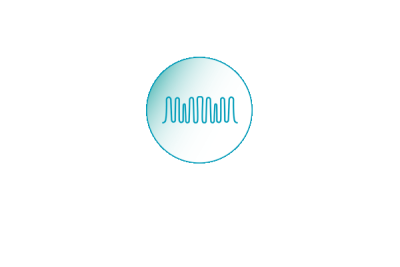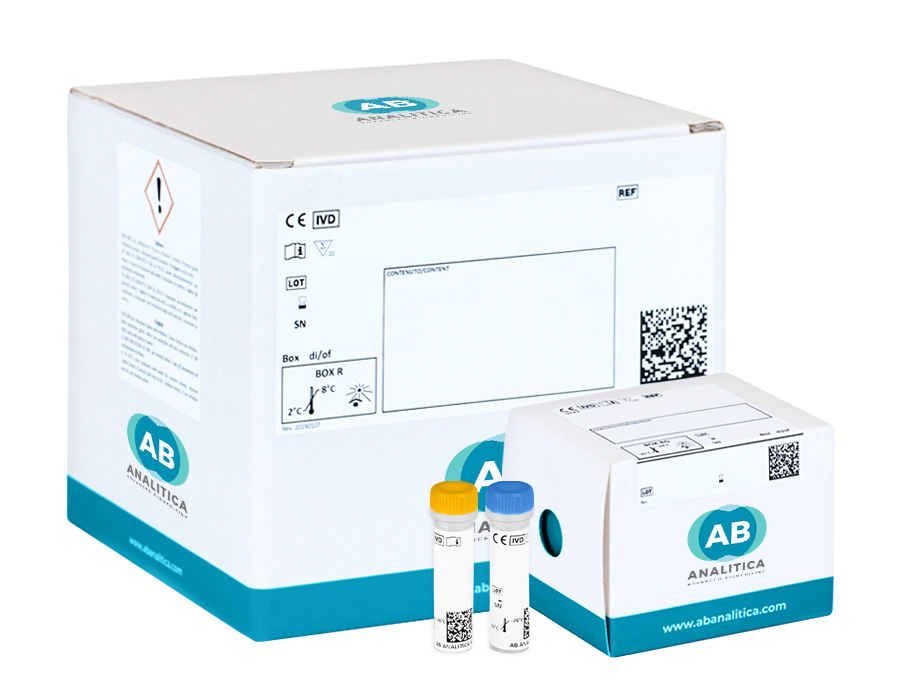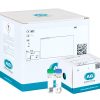Description
The GENEQUALITY AB-THROMBO TYPE PLUS kit is an IVD for the simultaneous detection of mutations in the genes coding for Factor II (G20210A), Factor V (G1691A/Leiden and H1299R), MTHFR (C677T and A1298C) and PAI-1 (polymorphism 5G/4G) by Reverse Line Blot (RLB).
Product Characteristics
- The assay requires only 2 µL of DNA extracted
- The automatic format of the assay can be used on different automatic instruments for Reverse Line Blot protocols
Kit content
Kit includes:
- Ready-to-use reagents for End-Point PCR
- Reference DNA
- Strips and reagents for amplicons visualization by Reverse Line Blot
- Transparent film for strip interpretation
- Strip collection sheet
- Tray with 8 single-use channels for Reverse Line Blot (only in the manual format)
Further Information
Venous thrombosis is the blocking of blood circulation caused by clots that form at the location of the thrombosis or have been released from a thrombus elsewhere in the (blood) circulatory system. Thrombi form most frequently in the surface veins and deep veins of the legs, but can also originate in the veins of the brain, the retina, the liver and the mesentery.
Factors that cause activation of the coagulation system (e.g. traumas, surgery, patient immobilization, pregnancy, oral contraceptives) as well as the genetic background of an individual may determine the development of venous thrombosis.
Mutations in the genes coding for proteins involved in hemostasis and fibrinolysis may lead to a high or heightened risk of venous thrombosis for an affected individual.
Several mutations in several genes have been identified which play a role in the development of venous thrombosis. The more frequent of these mutations are found in the genes for coagulation factors II and V (Factor II and Factor V), the Methylenetetrahydrofolate Reductase (MTHFR) and the Plasminogen Activator Inhibitor 1 (PAI-1).
Prothrombin or Factor II is the inactive precursor of Thrombin. The gene contains a 5’ UTR, 14 exons, 13 introns and a 3’ UTR. A frequent mutation in the 3’ UTR is associated with elevated levels of Prothrombin in the blood and an increased risk of venous thrombosis (Poort et al., 1996). The role of this G→A transition in position 20210 (G20210A) of the gene is not yet completely understood. Nonetheless, several studies have shown that heterozygous carriers of this mutation have by approx. 30 % increased levels of prothrombin and a 3-6 higher probability to develop venous thrombosis. This mutation is very rare among non-Caucasians, but found with a frequency of 0.7 to 4 % in Caucasian populations. The mutation G20210A appears to be an important risk factor facilitating thrombosis in cerebral veins as well as to act synergistically with oral contraceptives in increasing the thrombosis risk.
Factor V is a blood protein that plays an important role as inactive procofactor. It is activated by Thrombin by cutting into two chains which form the active, heterodimeric Factor Va. This active form is inactivated by the activated protein C (APC) which cleaves the heavy chain at the positions Arg 306, Arg 506 and Arg 679.
The current hypothesis is that thrombosis can be caused by a multitude of genetic mutations at critical positions of Factor V.
A G→A transition in exon 10 leads to the substitution of the Arginine at amino acid position 506 by a Glutamine. This mutated protein is called Factor V Leiden and is resistant to cleavage and thus to inactivation by APC. Therefore Factor V Leiden is called APC-resistant (Bertina et al., 1994).
Approx. 2 to 15 % of Caucasians are positive for Factor V Leiden, whereas it is extremely rarely found in non-Caucasians. Heterozygous carriers of Factor V Leiden have a 7 times increased risk to develop deep vein thrombosis. Factor V Leiden homozygous individuals have an up to 80 times higher probability to develop this condition.
Haplotype HR2 of Factor V describes a polymorphism in exon 13 (A→G transition in position 4070) of the Factor V gene which transforms allele R1 into allele R2 by substituting a histidine by an arginine at position 1299 of domain B of the Factor V protein (H1299R).
Several studies have identified the HR2 haplotype as a prothrombotic risk factor associated with APC-resistance and a pronouncedly lowered APC-ratio in vitro. Individuals who inherit haplotype HR2 and Factor V Leiden in trans have a significantly higher risk to develop thrombosis. In general, carriers of haplotype HR2 have increased levels of a Factor V isoform that shows higher glycosylation and is more prone to cause thrombosis (Gemmati et al., 1999).
Socalled hyperhomocysteinemia has been identified as a cerebrovascular risk factor for diseases of the peripheral vascular system and for coronary diseases.
Increased plasma levels of homocysteine can be linked to a certain genetic predisposition or be the result of diet associated alterations in the transsulfuration or remethylation processes.
The Methylenetetrahydrofolate Reductase (MTHFR) catalyzes the reduction of 5,10-methylenetetrahydrofolate to 5-methyltetrahydrofolate. Patients with coronary and peripheral artery disease were found to often have reduced MTHFR activity.
MTHFR mutation C677T is one of the most common hereditary defects of the homocysteine metabolism. The substitution of an alanine by a valine at position 223 renders the enzyme thermolabile, thus reducing its activity and causing hyperhomocysteinemia, particularly in the presence of low folate levels (Gemmati et al., 1999). GQ_AB-THROMBO_PLUS_manual_e20201021 9
Another mutation that is associated to a reduced activity of MTHFR is mutation A1298C.
The Plasminogen Activator Inhibitor 1 (PAI-1) is a glycoprotein that acts as inhibitor of the activation of Plasminogen in the blood and as such plays a key role in the formation of stable thrombi. An elevated concentration of PAI-1 has been associated with venous and arterial thrombosis, coronary diseases and myocardial infarction.
The promoter region of the PAI-1 gene carries a polymorphism that is defined by the deletion of a G in position 675 (4G/5G polymorphism).
In contrast to the 5G allele which binds enhancers as well as suppressors of transcription, the 4G allele is only capable of binding enhancers. Many studies have shown that individuals homozygous for the 4G allele have 25 % higher PAI-1 plasma levels than persons that are homozygous for allele 5G. As a result, the 4G/4G genotype (4G homozygous) is associated with a higher risk of coronary diseases and an increased risk of preeclampsia during pregnancy (Dawson, 1993).
As these risk factors may act synergistically if occurring together, it is an important advantage to be able to detect and identify them in parallel.
Ordering Information
| Code | Product | PKG |
|---|---|---|
| 04-71A-20 M | GENEQUALITY AB-THROMBO TYPE PLUS | 20 tests |
| 04-71A-20 A | GENEQUALITY AB-THROMBO TYPE PLUS Automatic format | 20 tests |









